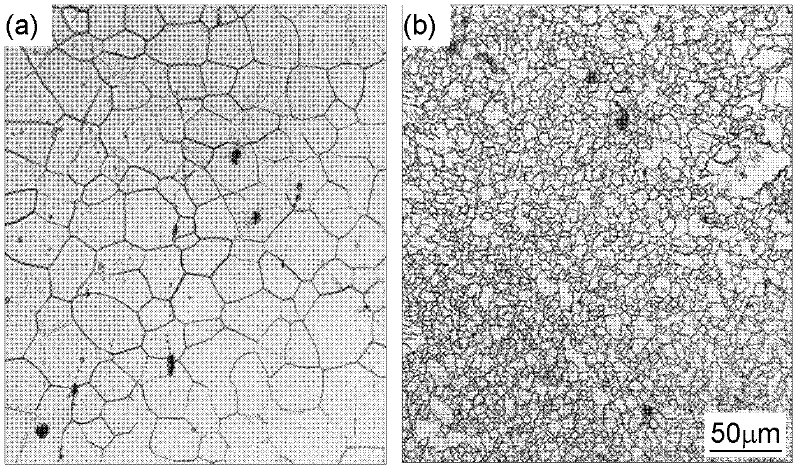Method for weakening cardinal plane texture of magnesium alloy plate strip
A magnesium alloy plate and texture technology, applied in the field of magnesium alloy processing, can solve problems such as poor ductility, and achieve the effects of overcoming the difficulty of weakening texture, easy operation and reasonable process design
- Summary
- Abstract
- Description
- Claims
- Application Information
AI Technical Summary
Problems solved by technology
Method used
Image
Examples
Embodiment 1
[0034] AZ31 magnesium alloy sheets were subjected to repeated wave bending at 370 °C using corrugated rolls. Place the plate between the corrugated rolls, the ratio of the distance H between the crest and the trough of the roll to the radius R of the crest or trough bending arc is: H:R=1.5, and the ratio to the thickness D of the plate is: H:D=2, adjacent The ratio of the distance L between the crests to the radius R of the crest or trough bending arc is: L: R = 5, the plate is rolled alternately for 4 passes, then the plate is straightened, water quenched, and the plate is heated to 370°C, keep warm for 20 minutes. attached by figure 1 and 2 It is known that after repeated wave bending of the plate, the grains are refined to less than 10 μm, the texture strength is significantly reduced, and the texture changes from strictly distributed in the normal direction of the plate to random distribution.
Embodiment 2
[0036] AZ31 magnesium alloy sheets were subjected to repeated wave bending at 420 °C using corrugated rolls. Place the sheet between the corrugated rolls, the ratio of the distance H between the crest and the trough of the roll to the radius R of the bending arc of the crest or trough is: H:R=1.5, and the ratio to the thickness D of the sheet is: H:D=1.2, adjacent The ratio of the distance L between the crests to the radius R of the crest or trough bending arc is: L: R = 3, the plate is rolled alternately for 6 passes, then the plate is straightened, water quenched, and the plate is heated to 420°C, keep warm for 20 minutes. attached by image 3 and 4 It is known that after repeated wave bending, the grains are refined to less than 10 μm, the grain orientation distribution is randomized, and the texture strength is significantly reduced.
Embodiment 3
[0038] The pure magnesium sheet was repeatedly wave-bent using corrugated rolls at 250 °C. Place the plate between the corrugated rolls, the ratio of the distance H between the crest and the trough of the roll to the radius R of the crest or trough bending arc is: H:R=1.5, and the ratio to the thickness D of the plate is: H:D=2, adjacent The ratio of the distance L between the crests to the radius R of the crest or trough bending arc is: L: R = 5, the plate is rolled alternately for 6 passes, then the plate is straightened, water quenched, and the plate is heated to 250°C, keep warm for 15 minutes. attached by Figure 5 It is known that after repeated wave bending, the grains of the plate are refined to less than 20 μm.
PUM
 Login to View More
Login to View More Abstract
Description
Claims
Application Information
 Login to View More
Login to View More - R&D
- Intellectual Property
- Life Sciences
- Materials
- Tech Scout
- Unparalleled Data Quality
- Higher Quality Content
- 60% Fewer Hallucinations
Browse by: Latest US Patents, China's latest patents, Technical Efficacy Thesaurus, Application Domain, Technology Topic, Popular Technical Reports.
© 2025 PatSnap. All rights reserved.Legal|Privacy policy|Modern Slavery Act Transparency Statement|Sitemap|About US| Contact US: help@patsnap.com



